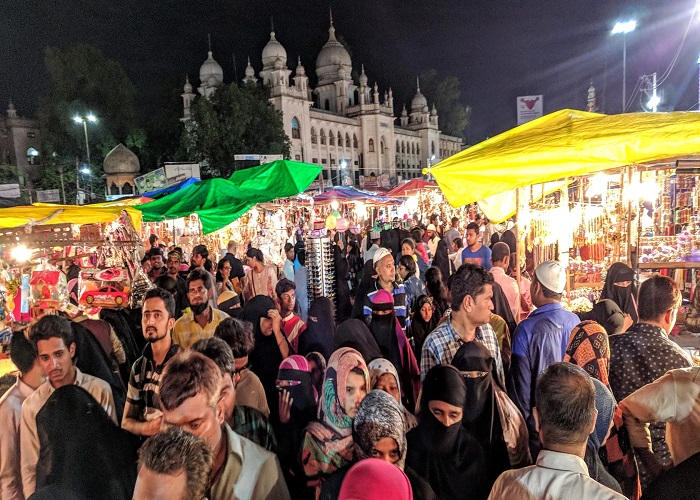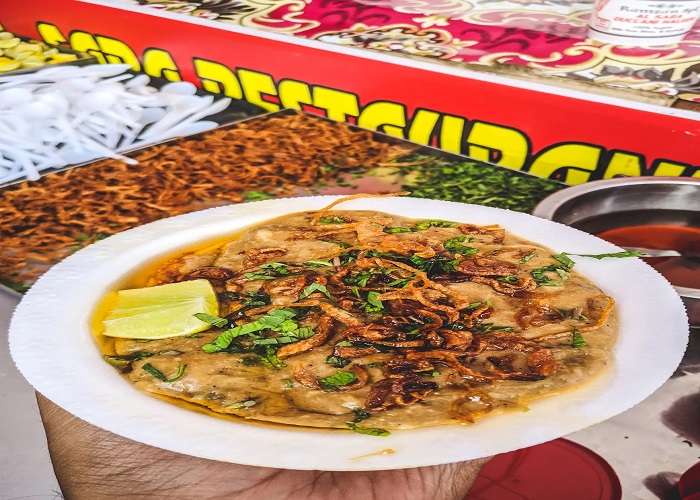
During the holy month, legions of cooks gather at restaurants, warehouses, and street stalls to spend hours mashing the savory porridge of mutton, wheat, and spices, a beloved fixture of night markets and family iftar feasts.
ForFor much of the year, dawn breaks over sleepy lanes in Hyderabad, India, as chai and newspaper vendors rush to deliver piping hot tea alongside the news. But during Ramadan, mornings in the Old City, Secunderabad, Mallepally, Tolichowki, and other neighborhoods bring a different kind of activity. Dozens of eateries and warehouses fill with workers starting the long process of making massive amounts of haleem, an iconic savory porridge-like dish enjoyed across the Muslim world but especially beloved in Hyderabad during Ramadan, when it becomes a staple of the nightly iftar meal.
Across its many locations, the legendary Pista House, a name nearly synonymous with haleem, prepares around two tons of the dish every day during the holy month. The operation at the restaurant, and at many others, is a communal effort. Legions of cooks (including many temp workers hired just for the month) set up firewood, chop mutton, grind wheat, prep lentils, clean herbs and chiles, strain rose petals, crush cardamom, chop cinnamon bark, and ready other spices and ingredients before piling everything into bhattis, mud or brick kilns fitted with huge cauldrons. Then it’s all hands on deck, as crews of Muslims as well as non-Muslims work like well-oiled machines, using wooden mallets to rhythmically pound the mixture as it cooks for up to 12 hours. (If you thought tricep dips were hard, try pounding tons of meat into a paste, every day for a month, while fasting.)

As the sun sets, the streets transform again with a new flurry of activity. The usually traffic-packed road around the iconic Charminar monument and mosque is blocked off to allow pedestrians to explore freely. Almost simultaneously, thousands of stalls spring up, selling all things festive: shimmery bangles, little jars of attar (perfume), colorful sarees, embroidered anarkalis. Here and across the city, restaurants shift their attention to serving the food they spent all day preparing. Workers distribute Styrofoam bowls filled with haleem, topped with caramelized onions, coriander, shorba (meat consomme), slices of lemon, and other fixings.
Mohammed Sibghatullah Khan of Deccan Archive, a digital publication preserving Hyderabad’s heritage, recalls relatives across Hyderabad coming together during his childhood to prepare the feast that follows the fast. “Back then, this was the only time I got to eat haleem,” he says. The more family members who showed up to help, the more the work could be shared, with everyone taking turns to lend a hand in preparing the dish (at home, many families cook the elements of haleem separately before combining and mashing them to make the work a bit easier). Today, his family heads to Shah Ghouse, a popular choice, to fetch “buckets of haleem,” he says. “Cooking this dish has become a rare sight” in his house, Khan adds with a chuckle.
After he offers his prayers, Khan breaks the fast with his community over dates, fresh and dried fruits, and a handful of pakoras, before everyone disperses to hit the stalls, alongside diners of all backgrounds eating, shopping, and searching for the best bowl of haleem.
How did haleem come to Hyderabad?
The dish can be traced back to Arabian cookbooks from the 10th century. A predecessor called harees (also spelled jareesh) also consists of mashed meat and wheat; it came to India with Arab mercenaries, likely from Yemen, during Muslim rule in Hyderabad under the Nizams. These soldiers enjoyed harees for breakfast, when its high calories were especially useful. The barracks that housed these mercenaries eventually gave their name to the Barkas neighborhood, today home to hundreds of thousands of Arab descendants. You’ll still find harees year-round in Barkas, like at the long-standing Madina Hotel and Hadrami Harees, two restaurants that inspire long lines of customers as early as 5 a.m. and often scrape the bottom of their pots for the last harees by 10 a.m. (A sweeter version of harees is also on the menu at some eateries, though it’s not as popular.)
Unlike mild harees, which usually calls for equal parts wheat and meat, haleem calls for double the meat. Over time, locals augmented the ratio and added more seasoning. Though Hyderabad is equally famous and protective of its biryani, during Ramadan, the rice dish is quite literally on the back burner — which alone speaks volumes about the passion for haleem.
Versions of haleem and related dishes are hugely popular in Pakistan, Bangladesh, Iran, West Asian countries, and Turkey. Across India, haleem can be found in Iranian restaurants in Mumbai; eateries in Bangalore’s Fraser Town, Old Delhi, Lucknow, Chennai, Ludhiana, and Goa; in traces in relative dishes like aleesa in Kerala, harissa in Kashmir, and khichra in Gujarat; and at many family gatherings and weddings.
Over the last decade especially, meat consumption, especially beef, has been a flash point for violence by right-wing Hindus on Muslim communities (as well as on Indigenous Adivasis and Dalits) as nationalists have pressed for the widespread adoption of vegetarianism. Given the context, the scene in Hyderabad during Ramadan, with crowds of Muslims, Hindus, and other non-Muslims all enjoying haleem, is striking.
What makes Hyderabadi haleem so popular?
At its best, haleem is an amalgamation of sensations and flavors — gamey mutton, subtly aromatic rose petals, punchy spices, slick ghee, generous fixings — all delivered in a caloric, easily digestible bowl. Anas Murtuza, the food critic behind BeingHydFoodie, claims he could fast for days after one bowl of haleem — though that doesn’t stop him from constantly visiting his go-to shop, City Diamond, a favorite of residents in Mehdipatnam..
World Opinions – Eater.com









